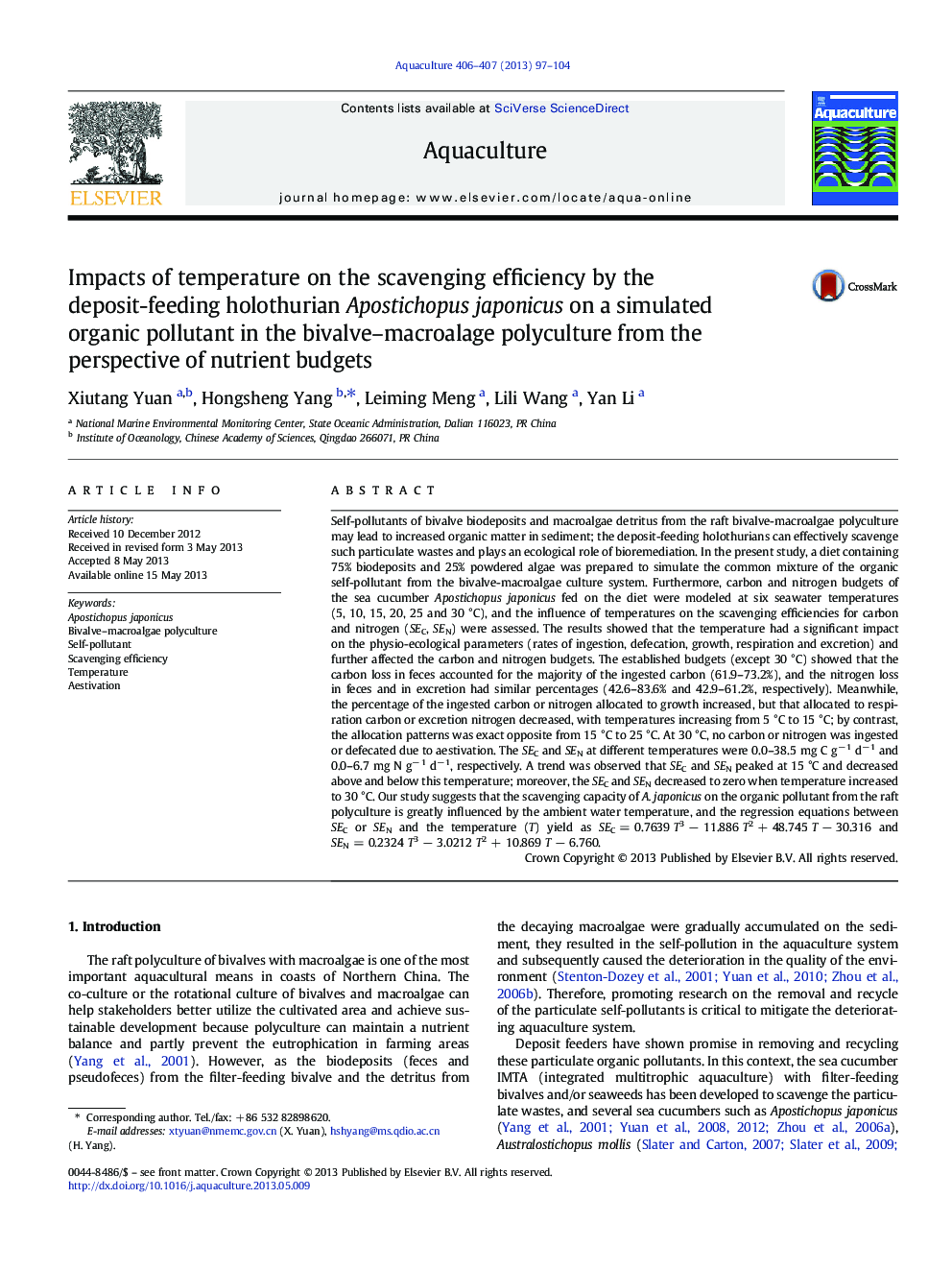| کد مقاله | کد نشریه | سال انتشار | مقاله انگلیسی | نسخه تمام متن |
|---|---|---|---|---|
| 8495604 | 1552870 | 2013 | 8 صفحه PDF | دانلود رایگان |
عنوان انگلیسی مقاله ISI
Impacts of temperature on the scavenging efficiency by the deposit-feeding holothurian Apostichopus japonicus on a simulated organic pollutant in the bivalve-macroalage polyculture from the perspective of nutrient budgets
دانلود مقاله + سفارش ترجمه
دانلود مقاله ISI انگلیسی
رایگان برای ایرانیان
کلمات کلیدی
موضوعات مرتبط
علوم زیستی و بیوفناوری
علوم کشاورزی و بیولوژیک
علوم آبزیان
پیش نمایش صفحه اول مقاله

چکیده انگلیسی
Self-pollutants of bivalve biodeposits and macroalgae detritus from the raft bivalve-macroalgae polyculture may lead to increased organic matter in sediment; the deposit-feeding holothurians can effectively scavenge such particulate wastes and plays an ecological role of bioremediation. In the present study, a diet containing 75% biodeposits and 25% powdered algae was prepared to simulate the common mixture of the organic self-pollutant from the bivalve-macroalgae culture system. Furthermore, carbon and nitrogen budgets of the sea cucumber Apostichopus japonicus fed on the diet were modeled at six seawater temperatures (5, 10, 15, 20, 25 and 30 °C), and the influence of temperatures on the scavenging efficiencies for carbon and nitrogen (SEC, SEN) were assessed. The results showed that the temperature had a significant impact on the physio-ecological parameters (rates of ingestion, defecation, growth, respiration and excretion) and further affected the carbon and nitrogen budgets. The established budgets (except 30 °C) showed that the carbon loss in feces accounted for the majority of the ingested carbon (61.9-73.2%), and the nitrogen loss in feces and in excretion had similar percentages (42.6-83.6% and 42.9-61.2%, respectively). Meanwhile, the percentage of the ingested carbon or nitrogen allocated to growth increased, but that allocated to respiration carbon or excretion nitrogen decreased, with temperatures increasing from 5 °C to 15 °C; by contrast, the allocation patterns was exact opposite from 15 °C to 25 °C. At 30 °C, no carbon or nitrogen was ingested or defecated due to aestivation. The SEC and SEN at different temperatures were 0.0-38.5 mg C gâ 1 dâ 1 and 0.0-6.7 mg N gâ 1 dâ 1, respectively. A trend was observed that SEC and SEN peaked at 15 °C and decreased above and below this temperature; moreover, the SEC and SEN decreased to zero when temperature increased to 30 °C. Our study suggests that the scavenging capacity of A. japonicus on the organic pollutant from the raft polyculture is greatly influenced by the ambient water temperature, and the regression equations between SEC or SEN and the temperature (T) yield as SEC = 0.7639 T3 â 11.886 T2 + 48.745 T â 30.316 and SEN = 0.2324 T3 â 3.0212 T2 + 10.869 T â 6.760.
ناشر
Database: Elsevier - ScienceDirect (ساینس دایرکت)
Journal: Aquaculture - Volumes 406â407, 25 August 2013, Pages 97-104
Journal: Aquaculture - Volumes 406â407, 25 August 2013, Pages 97-104
نویسندگان
Xiutang Yuan, Hongsheng Yang, Leiming Meng, Lili Wang, Yan Li,